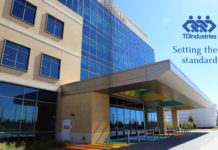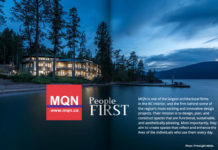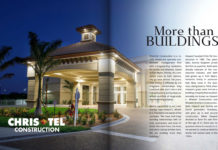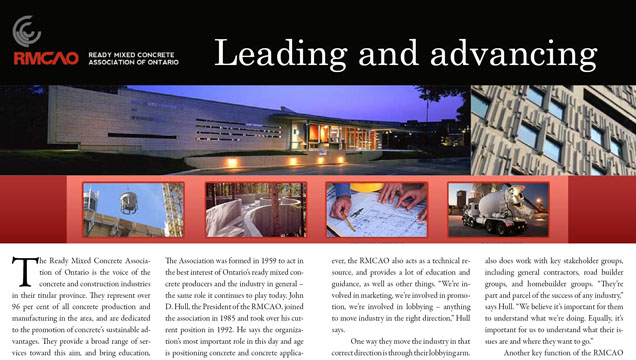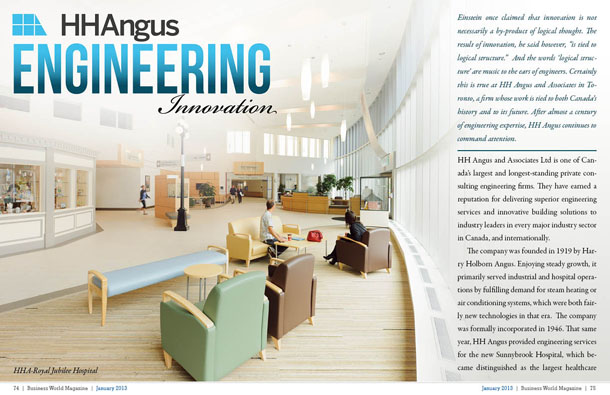

Einstein once claimed that innovation is not necessarily a by-product of logical thought. The result of innovation, he said however, “is tied to logical structure.â€Â And the words ‘logical structure’ are music to the ears of engineers. Certainly this is true at HH Angus and Associates in Toronto, a firm whose work is tied to both Canada’s history and to its future. After almost a century of engineering expertise, HH Angus continues to command attention.
HH Angus and Associates Ltd is one of Canada’s largest and longest-standing private consulting engineering firms. They have earned a reputation for delivering superior engineering services and innovative building solutions to industry leaders in every major industry sector in Canada, and internationally.
The company was founded in 1919 by Harry Holborn Angus. The company experienced steady growth, primarily serving industrial and hospital operations by fulfilling demand for steam heating or air conditioning systems, which were both fairly new technologies in that era. The company was formally incorporated in 1946. That same year, HH Angus provided engineering services for the now-1600 bed Sunnybrook Hospital, which became distinguished as the largest healthcare facility in the British Commonwealth. The company went on to design for a variety of other hospitals. In the early 1960s, their engineering contributed to the development of the district heating system that serviced a majority of buildings in Toronto’s downtown core, with over five miles of underground distribution piping. The system now serves over 130 buildings in the city.
When Harry Holborn Angus passed away in 1959, the company’s legacy of innovation continued under the direction of his son, Donald. The company worked on the military’s Semi-Automatic Ground Environment. Known as SAGE, the work was commissioned by the NATO. HH Angus helped create the facility for continental missile and radar systems to deter potential threats from nuclear attack. It was a very innovative project and became Canada’s first raised floor installation for cooling. Moving on to other ‘firsts’, HH Angus provided engineering services for the landmark Toronto Dominion Centre, designed by renowned architect Ludwig Mies Van Der Rohe. At the time, it was the tallest building in Canada. One of the challenges met by HH Angus was in designing systems which would deliver building services to offices that were higher than ever before.
To be sure, this company’s role is measured beyond terms of traditional design. Led by third generation President Harry Gordon Angus since 1985, today HH Angus specializes in creating solutions to challenging problems; for example, their design for chilled beams for the Toronto Dominion Tower renovations delivered benefits to both owners and tenants. Another example was HH Angus’ design support to Kodak Canada in the development of a chemical plant where polyethylene tetrathyalate resin was used to produce plastic bottles. Without detailing what some might construe as mind-numbing science, HH Angus helped to devise an entirely new manufacturing approach and method which resulted in cost savings and dramatically increased productivity – call it a Kodak moment.
Baseball’s Blue Jays or Football’s Argonauts may attract most of the cheers from sports fans at Toronto’s Rogers Centre (formerly the Skydome), but for engineers, it’s the structure’s fully-retractable motorized roof that is the attraction, and is recognized as a world first for a sports stadium. Another stadium design feature from HH Angus was a thermal system that directs cool air downward to the seats. The air then rises again as it warms, improving air movement in the facility. The system helps provide both comfort and cost savings, something everyone can cheer about.
And there is much more. From engineering the world’s first high-speed moving sidewalk at Toronto’s Pearson International Airport, or engineering Ontario’s first LEED “Gold†certified healthcare facility for North Bay Regional Healthcare Centre, to devising the first “double façade ventilation system†for the University of Toronto’s Terrence Donnelly Centre for Cellular and Biomolecular Research, the accomplishments of HH Angus are a technician’s field guide to innovation.
And none of this legacy of innovation has been lost in the thinking of Tom Halpenny. As Vice President of Operations and General Manager, he says the company’s century-old reputation not only fosters pride, but compels their commitment to continue innovating. “We take great pride in striving for excellence and working hard to remain at the forefront of design through leading edge technology, standards and practices,†says Halpenny.
Dissecting Divisions
Engineering consulting services at HH Angus are streamed into four divisions – commercial, energy/industrial, healthcare and technology. This approach focuses the experience and knowledge of their professionals into core specialties which results in leveraging the greatest capability for their clients. Their ability to provide technical support, design and project management for building services projects offers their clients a comprehensive range of services from concept to commissioning.
“It is a collaborative approach to design, rather than just getting the drawings and putting the mechanical electrical system on it,†Halpenny says. “We enjoy the opportunity to get involved with a project from the beginning, and to bring value-added advice and innovation to our clients.â€
Because they are privately-owned, HH Angus and Associates also has flexibility in their processes, which allows them to be more innovative, according to Barbara Bradley, Vice-President of Marketing and Business Development. “While we’re always keeping an eye on the bottom line, as a private firm, we have more freedom to invest additional time on solutions for our clients’ needs.â€
The company’s strong commitment to the needs of their clients and staff is another highlight of HH Angus’ success. Their long-standing client relationships are a result of consistent service and successful outcomes. More than 70 percent of their portfolio comes from repeat business.
To execute such strong customer service, HH Angus and Associates relies on staff of more than 200, including more 50 licensed professional engineers and almost 60 LEED-accredited employees. High employee retention is a source of pride within the firm, and more than 40 employees have been with HH Angus for over 20 years. “We retain very good staff who love to take on challenging work and who love to solve problems,†says Halpenny. “We’re always looking for people with initiative who bring innovation to the design process.â€
Sustainable Services
HH Angus and Associates Limited has always approached their projects from a sustainable mindset. Energy use and sustainability are now major drivers in the built environment, as owners – whether public or private – are looking to maximize their ROI on infrastructure spending. “It doesn’t make much sense to design a building that isn’t energy-efficient. From the company’s earliest days, we’ve looked at how to do that most efficiently,†says Bradley.
It is the mandate of their professional engineers to make sure they design an efficient building. Lifecycle costing is becoming a key element of sustainable energy systems design, and applies to everything they do. “Sustainability and green initiatives are more and more important to our clients, and it’s part of our craft to make sure we do that well,†Halpenny says.
“We get involved in a lot of the standards that are used in our practices for healthcare and electrical codes, and we use our knowledge to make sure those codes allow people to design in energy-efficient ways,†he adds.
IT Innovations
At HH Angus and Associates Limited, their Technology Division engineers systems to provide continuous service and near-zero probability of failure, delivering innovative and dependable technology solutions wherever complete system reliability is needed. This includes such highly-serviced buildings such as hydro control facilities, data centres, laboratory and research buildings, telecommunications systems, transit systems, and others.
“Ten years ago, no one was designing buildings with wireless systems, and now it’s just a matter of fact. But we were thinking about it back then, making sure we designed so that the systems could be added.†Halpenny says.
“We were stretching our thoughts to the most advanced IT infrastructure, so that five or six years down the road, we could more easily implement that infrastructure for our clients.
LEEDing the Way
HH Angus and Associates Limited recently finished working on a number of new projects that just opened to the public, including two hospitals that have reached LEED status. For a long time, hospitals didn’t have a standard to follow for LEED because LEED was primarily for commercial buildings,†Halpenny says.
“The North Bay Regional Hospital was the first hospital to get LEED certification. We’ve also just opened up Royal Jubilee Hospital in Victoria, B.C., which has reached Gold certification – the first hospital in Canada to receive that.â€
The company is currently working on renovations for the Toronto-Dominion Centre, which consists of the first three skyscrapers built in the city in the 1960s. The 100 Wellington Tower has been certified LEED Platinum, and the Centre itself is LEED Gold. “We were the original systems designers for the Centre, and we convinced them they needed to change the glass on the outside of the building to a thermal pane because it was originally single pane. We’ve also changed the heating and cooling in the building to make it more comfortable and more energy-efficient,†he says.
Looking ahead, HH Angus will continue to maintain the values they’ve refined over the last century and use them to keep driving their business and their industry forward. According to Bradley, “As far as the future goes, we will stay the course and identify developments, in our market as well as global markets. We will also improve our technology and invest in our people, because that’s the basis for how we work.â€


